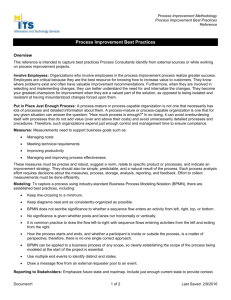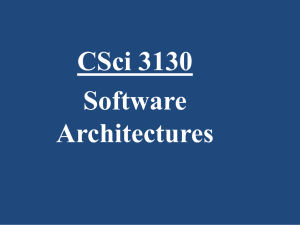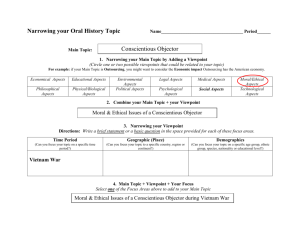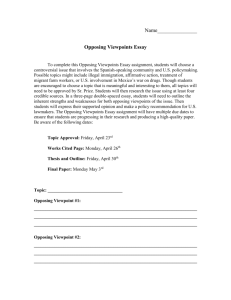Using Domain Specific Languages for Software Process Modeling
advertisement
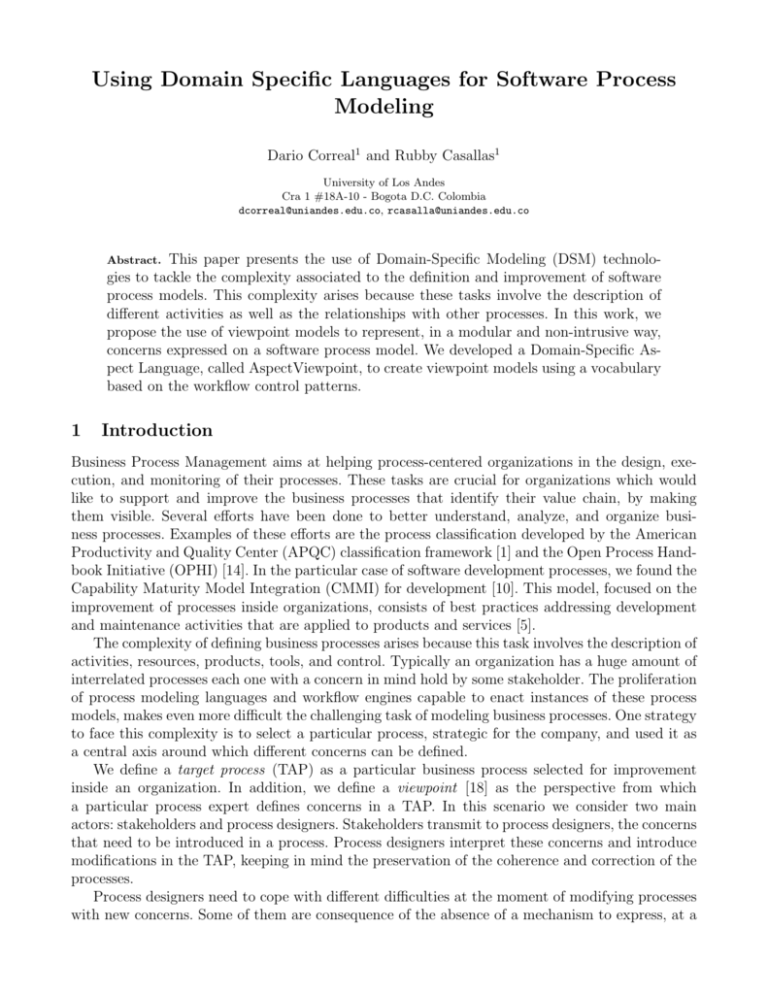
Using Domain Specific Languages for Software Process
Modeling
Dario Correal1 and Rubby Casallas1
University of Los Andes
Cra 1 #18A-10 - Bogota D.C. Colombia
dcorreal@uniandes.edu.co, rcasalla@uniandes.edu.co
This paper presents the use of Domain-Specific Modeling (DSM) technologies to tackle the complexity associated to the definition and improvement of software
process models. This complexity arises because these tasks involve the description of
different activities as well as the relationships with other processes. In this work, we
propose the use of viewpoint models to represent, in a modular and non-intrusive way,
concerns expressed on a software process model. We developed a Domain-Specific Aspect Language, called AspectViewpoint, to create viewpoint models using a vocabulary
based on the workflow control patterns.
Abstract.
1
Introduction
Business Process Management aims at helping process-centered organizations in the design, execution, and monitoring of their processes. These tasks are crucial for organizations which would
like to support and improve the business processes that identify their value chain, by making
them visible. Several efforts have been done to better understand, analyze, and organize business processes. Examples of these efforts are the process classification developed by the American
Productivity and Quality Center (APQC) classification framework [1] and the Open Process Handbook Initiative (OPHI) [14]. In the particular case of software development processes, we found the
Capability Maturity Model Integration (CMMI) for development [10]. This model, focused on the
improvement of processes inside organizations, consists of best practices addressing development
and maintenance activities that are applied to products and services [5].
The complexity of defining business processes arises because this task involves the description of
activities, resources, products, tools, and control. Typically an organization has a huge amount of
interrelated processes each one with a concern in mind hold by some stakeholder. The proliferation
of process modeling languages and workflow engines capable to enact instances of these process
models, makes even more difficult the challenging task of modeling business processes. One strategy
to face this complexity is to select a particular process, strategic for the company, and used it as
a central axis around which different concerns can be defined.
We define a target process (TAP) as a particular business process selected for improvement
inside an organization. In addition, we define a viewpoint [18] as the perspective from which
a particular process expert defines concerns in a TAP. In this scenario we consider two main
actors: stakeholders and process designers. Stakeholders transmit to process designers, the concerns
that need to be introduced in a process. Process designers interpret these concerns and introduce
modifications in the TAP, keeping in mind the preservation of the coherence and correction of the
processes.
Process designers need to cope with different difficulties at the moment of modifying processes
with new concerns. Some of them are consequence of the absence of a mechanism to express, at a
higher level of abstraction, process concerns in the language used by the stakeholders. Others are
consequence of the increment of activities, and relationships appended to a target process, making
difficult to be aware of the actual impact of each modification in the overall process. Finally, the
lack of a mechanism to define the interaction between the concerns and the TAP can lead to
inconsistent states and deadlocks found, most of the times, at execution time.
The main goal of this document is to propose a mechanism to support process designers with
the expression of concerns in software processes. We developed a domain-specific aspect language
(DSAL), called AspectViewpoint, to support the definition of concerns in this type of processes.
The rest of this paper is organized in the following way: section two presents the Business
Process Modeling Notation (BPMN) [9]. Section three presents the use of viewpoints to model
concerns defined around a software process. Section four presents the AspectViewpoint language.
Section five presents the implementation used in this work. Section six presents our current experimentation and results. Finally, we present some conclusions and future work.
2
Business Process Modeling
The Business Process Modeling Initiative (BPMI) [3], which is part of the Object Management
Group (OMG), defines and maintains the BPMN. The BPMN specification aims at standardizing
business process models using a graphical language to express the activities, products, and participants involved in a process definition. The BPMN is composed of a set of graphical elements
that can be grouped into four main categories: flow objects, connecting objects, swimlanes, and
artifacts [9]. Flow objects comprise the large set of graphical elements defined by the BPMI and
are used to model the execution of a business process. These elements are classified into three
categories: activities, gateways, and events.
The process presented in figure 1 gives an example of a software development process defined
with the BPMN specification. In this example, the process starts with the CreateDLD activity,
which creates the detailed design. The next activity is Codification, which according to the process,
can be executed at two different points: after the finalization of the CreateDLD activity or the
UnitTesting activity. In the first case, Codification implements the design when it is ready. In the
second case, Codification is executed to correct any defects in the code found by the UnitTesting
activity after the register of the defects by the RegisterDefects activity. To model this situation, a
DataXor gateway is used to define the convergence of the UnitTesting and CreateDLD activities
before the execution of the Codification activity. After UnitTesting, there are two possible execution
paths: if defects are present, Codification takes place again; if no defects are found, a baseline of
the product is created by the CreateBL activity and the process finishes.
Fig. 1. Example of a BPMN process model.
3
Software Process Viewpoints
To introduce the viewpoint concept, we present first the following example. Consider again the
software process model presented in figure 1. Around this process, stakeholders could express different concerns, like the process planning, the monitoring, and control of the process, and the
configuration management of the process. In the figure 2, we present a target process (TAP) modeling our software development process, and the different concerns expressed by the stakeholders,
around this process.
Fig. 2. Concerns defined around the software process model
In a typical scenario, process designers need to incorporate these concerns into the software
process model to obtain a process similar to the presented in figure 3. However, this is a challenging
and cumbersome task if we consider that industry software processes are composed of hundred of
activities and they need to be adapted with different concerns several times.
Fig. 3. The software process model modified with different viewpoints
Most common process modeling languages, like XPLD [4] or BPEL [2], do not offer the necessary
mechanisms to express concerns associated to a process model. Thus, process designers need to
modify the process directly into its definition.
To tackle these problems, we propose a process adaptation mechanism based on domain-specific
modeling technologies. In our approach, we define processes in a technology-independent way, using
a model based on the BPMN notation. Additionally, we use viewpoints to define the perspective
from which a process is viewed by the stakeholders. Our objective is to assist process designers
with the definition of viewpoints in target process models.
4
The AspectViewpoint Language
Domain-Specific Aspect Languages (DSALs) support the definition of crosscutting concerns using
the vocabulary and concepts of a particular domain. In this section, we present AspectViewpoint,
a DSAL designed for process models. In this domain, stakeholders of a process express concerns
regarding the activities, products, and participants that affect both the structure of the model and
its execution control flow.
In the AspectViewpoint language, a viewpoint defines the points in a process model where
the concerns have an effect, as well as the strategies that implement these concerns. Within the
design of the language, we created the Viewpoint Join Point Model (VJPM), which defines the set
of valid join points, pointcuts and advices in a process model. The join points and pointcuts are
defined in terms of the elements of a BPMN process model. The advices can be expressed in terms
of the workflow control patterns [22]. The AspectViewpoint language offers constructors to define
the points in the process affected by the concerns, and the actions to perform in those points to
modify the target process model.
4.1
Pointcut Definition
A join point specifies where an aspect might insert adaptations. In our case, we have defined a
join point model based on the behavior of three of the BPMN elements: activities, gateways, and
events. Pointcuts represent sets of join points, selected using queries on the join point model. In
the next section, we present an example of pointcut definitions.
4.2
Advices and Workflow Control Patterns
Advices define actions to be performed once a pointcut is reached. These actions can be as simple
as adding a new activity after or before a pointcut or as complex as changing the control flow of
the process using new gateways to link the activities. To facilitate the task of defining advices,
the AspectViewpoint language offers a set of primitives based on the workflow control patterns to
express changes in the control flow such as parallel splits, parallel joins, synchronization points,
and arbitrary cycles. We call the association between a pointcut and a set of actions a strategy.
The use of workflow patterns eases the understanding of the semantics of each strategy during
the process execution, using a high level of abstraction and a vocabulary adopted by the workflow
community. Workflow control patterns are now widely used as a common vocabulary between
process designers.
To illustrate the use of the AspectViewpoint language, consider the software process model
presented in the figure 1 and the monitoring and control concern presented in figure 2.
For simplicity, we present only the adaptation associated to the monitoring of the Codification
activity. In the first place, process designers and stakeholders define the desired strategy to implement this adaptation. The following list summarizes the activities that need to be done into the
original process model.
– Locate the Codification activity.
– Create the MonitorSchedule activity to control the progress of the project against the original
schedule of the project.
– Create the MonitorCostAndEffort activity to measure the current cost and effort against the
original plan.
– Create the activity MonitorDataMgm, which controls changes, such as requirements modifications, to the data.
– These three activities must be finished before the execution of the RegisterMCData activity
– Locate the Codification activity.
The following step in our strategy is the use of viewpoints to represent the activities included
in the strategy.
The listing 1.1 presents the AspectViewpoint code to implement the monitoring viewpoint.
First, in line 6, we define a pointcut called findCodification to locate the codification activity
inside the process model. Then, in line 12, we define an adaptation strategy associated to the findCodification pointcut. Inside the strategy, we created three new activities called MonitorSchedule,
MonitorCE, MonitorDataMgm and RegisterData (lines 16, 19, 22, and 25). The next step is to
express, using the workflow patterns vocabulary, the adaptations required into the execution flow
of the process. Particularly, in line 28, we define a ParallelSplit pattern to express that the three
new activities (MonitorSchedule, MonitorCE, and MonitorDataMgm) must be executed in parallel
after the finalization of the Codification activity. In line 32, we use a Synchronization pattern to
express that these new activities must be synchronized before the execution of the RegisterData
activity.
1
2
3
4
5
6
7
8
9
10
11
12
13
14
15
16
17
18
viewpoint P l a n n i n g P r o c e s s
a f f i l i a t i o n Engineering
targetprocess T e c h n i c a l S o l u t i o n M o n i t o r {
// Locate t h e C o d i f i c a t i o n t a s k
pointcut f i n d C o d i f i c a t i o n (Task t a s k ) :
target ( t a s k ) && name ( " Codification " ) ;
// C r e a t e s a P a r a l l e l S p l i t f o r t h e c o n t r o l and m o n i t o r i n g t a s k s
strategy addControlDLD ( Task t a s k ) : a f t e r findCreateDLD ( t a s k ) {
Task sch , e f f o r t , data , r e g ;
sc h = t a s k . parent ( ) . newFlowObject ( " MonitorSchedule " , "Task" , "Normal" ) ;
e f f o r t = t a s k . parent ( ) . newFlowObject ( " MonitorCE " , "Task" , "Normal" ) ;
data = t a s k . parent ( ) . newFlowObject ( " MonitorDataMgm " , "Task" , "Normal" ) ;
r e g = t a s k . parent ( ) . newFlowObject ( " RegisterData " , "Task" , "Normal" ) ;
t a s k . P a r a l l e l S p l i t ( [ sch , "" ] , [ e f f o r t , "" ] , [ data , "" ] ) ;
r e g . Synchronization ( [ sch , "" ] , [ e f f o r t , "" ] , [ data , "" ] ) ;
}
}
Listing 1.1. The Monitor Viewpoint implementation
5
Viewpoints as Models
The approach we use is model-driven development. Specifically, our work is based on three metamodels: process, viewpoint, and conciliation. Figure 4 presents an overview of these metamodels
and the relationships between them.
Fig. 4. Overview of the metamodels proposed in our solution
5.1
Metamodels
The process metamodel is used to define target process models. The viewpoint metamodel defines
the viewpoints representing concerns expressed by the stakeholders of the process. Finally, the
conciliation metamodel integrates the different viewpoints into a language-independent model and
detects possible conflicts between them.
We base the definition of our process metamodel on the BPMN. From the BMPN specification,
we have inferred a process metamodel, which was inspired by the work of [11] and [15]. The process
metamodel plays two important functions in our approach. First, it supports the definition of target
process models conforming to the BPMN metamodel. Second, it is used during the transformation
of target process models into platform-specific processes to be executed in a workflow engine.
We defined a viewpoint metamodel to aid process designers with the definition of concerns in
target process models. Viewpoint models express where in the process, process designers want to
introduce adaptations, and how this adaptations affect the normal execution of the process.
The conciliation metamodel is the third component in our solution, and it plays two important
roles. First, viewpoint models, defined by the AspectViewpoint language, are transformed into a
language-independent model. Second, two or more viewpoints could define incoherent modifications
on the target process. The conciliation metamodel is used to detect and solve these problems.
5.2
Model Weaving
Once the viewpoints are defined using the AspectViewpoint language, we transform these models into the Conciliation model. This model has to main elements: the Process Weaving Engine
(PWE) model and the resolution model. The PWE model expresses in a language-independent way
the viewpoints expressed on a process model. The resolution model is used to detect potentially
conflicts and interferences between viewpoints.
The PWE model is used to define the weaving strategies required to incorporate viewpoints
into the target process. These strategies are transformed into platform-specific weaving strategies,
ready to be used by a particular model weaving engine. The selected weaving engine, weaves the
target process model and the viewpoints models and produces a new version of the software process
model.
The figure 5 presents the resulting process model of our example after the weaving of the
viewpoint model with the target process model.
Fig. 5. The software process model after the weaving of the monitoring viewpoint
6
Implementation
We base the implementation of our work in two different domain-specific modeling platforms.
First, we use the Generic Modeling Environment (GME)[12] for the definition of process models.
Second, we use the OpenArchitectureware (oAW) framework [16] to define the viewpoint and the
conciliation metamodels. In this section, we present the implementation of our strategy in three
parts: the definition of target process models, the definition of viewpoints, and the weaving of the
target process model and the viewpoint models.
6.1
Target Process Definition
Process designers define target processes models, using the BPMN metamodel that we defined
thought the GME tool. This means, that the BPMN metamodel conforms to the MetaGME metametamodel, and the target process models conform to the BPMN metamodel.
6.2
Viewpoint Definition
Process designers describe the viewpoints expressed by stakeholders via the AspectViewpoint language. We have implemented a specific editor for our language using the OpenArchitectureware
(oAW) framework. We used the Xtext [8] language, part of oAW, to define an extended BNF
grammar. The oAW framework takes this grammar and generates an eclipse plugin-editor for the
language. We enriched the editor with syntactic and semantic extensions developed using other
oAW tools to allow the definition of semantic constrains checked when the process designer is
creating a viewpoint. Furthermore, using this approach, viewpoints created with the editor are
transformed into models conform to the Viewpoint metamodel produced also for the oAW framework based on the extended grammar of the language. This implementation is based on the Eclipse
development platform and the Ecore metametamodel.
6.3
Weaving the Target Process and the Viewpoints
To perform the weaving of the viewpoint models and the target process model, we use the PWE
model obtained as a result of the transformation of the viewpoint models. We use the Extend [7]
language, part of oAW to transform viewpoint models into the PWE model. The PWE model
is used to create platform specific weaving strategies in a language called Embedded Constraint
Language (ECL) [13]. The ECL language offers a mechanism of selection and aggregation of model
elements, as well as transformation operations to modify these models [13]. The generation of ECL
strategies is done using the Xpand [6] language provided by the oAW framework.
The ECL strategies are used by the Crosscutting-Specification Aspect Weaving (C-SAW) engine
[17], a plug-in for the GME tool, which enables us to weave on a model aspects expressed in the
ECL language. The resulting weaving process generated by C-SAW is a new BPMN process model
conforms to our BPMN metamodel.
7
Experimentation
We have experimented our solution in a software development company with a technical solution
process area at level one of the CMMI model for process improvement and the objective is to
modify the process to achieve level two. The test cases in this scenario showed how the generic
practices (concerns) associated with each process area of CMMI were easily defined using our
viewpoint language. Furthermore, we demonstrate that these concerns can be weaved with the
process model to obtain a complete view of the processes.
So far we have defined five of the generic practices suggested by the CMMI: Planning Process,
Training People, Manage Configuration, Monitor and Control, and Evaluate Adherence. As a
result, process designers use the AspectViewpoint language to define five viewpoints, one for each
generic practice. We had to define eleven strategies in total, using 20 workflow patterns. Instead
of working with more than fifty elements of the process model at the same time, each stakeholder
had to work only with the elements of his own concern.
Our general conclusion with the experimentation was that the complexity of the task of defining
the general process was reduced because of the use of our language.
8
Results and Conclusions
The Generic Modeling Environment (GME) proved to be a powerful tool in the creation of DomainSpecific models. Particularly, the BMPN metamodel developed with GME, facilitated us the definition of software process models. In all the cases, GME proved to be stable and easy to use. Our
strategy of using a model editor instead of a graphics editor to create BPMN processes was a success. Thanks to this decision, we could manipulate the model, reflexively, introducing adaptations
in the process model in a programmatic way.
The main limitation found during this phase was the absence of swimlanes in the editor provided
by the GME. This limitation made difficult the association of participants of the process with their
activities as required by the BPMN specification.
The viewpoint definition was done using the AspectViewpoint language, which proved to be
suitable for the definition of the join points, pointcuts and strategies required to solve each of
the concerns. In our testing, we successfully used six of the proposed workflow control patterns:
sequence, parallel split, synchronization, exclusive choice, arbitrary cycles, and merge. By means of
these patterns, we helped process designers to express in a Domain-Specific language the requirements expressed by stakeholders. Particularly, process designers found useful the incorporation
of the workflow patterns as part of the vocabulary of the language and the ability to define, in
separate modules, the concerns expressed by the stakeholders. Process designers expressed that
these characteristics facilitated to understand the effects of the changes introduced on the target
process after the weaving of each viewpoint.
We were able to create a conciliation model representing the weaving strategies of the testing
scenario. This model was used as a pivot to transform the adaptations defined in the viewpoint
models, using the AspectViewpoint language, into ECL weaving strategies.
The use of the OpenArchitectureware framework was fundamental in the achievement of these
objectives. First, because it provides the necessary means to define the grammar of our DomainSpecific Aspect Language, and second, it provides the transformation languages required to manipulate the different metamodels proposed in our strategy.
Furthermore, we succeeded in the integration of two different platforms used for DomainSpecific Modeling, using the ECL language as a bridge between both frameworks: GME and
OpenArchitectureware.
We used the C-SAW weaving engine to effectively transform the target process by weaving the
strategies defined in the PWE model. The weaving process was performed successfully and the
resulting woven process contained the modifications defined by the stakeholders of the process.
We succeeded in the transformation of the resulting woven process model of the software
scenario, into an executable Cumbia model. We proved in this way, that it is possible to support
the execution of complex workflow processes in which several crosscutting concerns have been
defined.
As a future work, we are planning to develop a graphical interface for the AspectViewpoint
language to define viewpoints directly into de process model diagram. This tool will support also;
the visualization of interferences found between different viewpoints.
Acknowledgments
This work was funded by the Institituto Colombiano Para el Desarrollo de la Ciencia y la Tecnologı́a - Francisco José de Caldas (COLCIENCIAS) and by the Natural Sciences and Engineering
Research Council of Canada (NSERC-CRSNG).
References
[1] APQC. American Productivity and Quality Center (apqc). Web Site, 2006. http://www.apqc.org
[2] Microsoft Corporation BEA. BEA Systems, International Business Machines Corporation. Business process execution
language for web services version 1.1. Technical report, 2003.
[3] BPMi. Business Process Modeling Initiative (bpmi). Web Site, 2006. http://www.bpmi.org/.
[4] WFMC. Workflow Management Coalition. Workflow process definition interface – xml process definition language version
1.0. Technical report, Workflow Management Coalition, 2002.
[5] Mary Beth Chrissis, Mike Konrad, and Sandy Shrum. CMMI Guidlines for Process Integration and Product Improvement,
2nd ed. Addison-Wesley Longman Publishing Co., Inc., Boston, MA, USA, 2006.
[6] Kadura C. Effinge, S. Openarchitectureware 4.1 xpand language reference. Technical report, OpenArchitectureWare.org,
2006.
[7] Sven Effinge. Openarchitectureware 4.1 extend language reference. Technical report, OpenArchitectureWare.org, 2007.
[8] Sven Effinge. Xtext reference documentation. Technical report, OpenArchitectureWare.org, 2007.
[9] OMG. Object Management Group. Business process modeling notation (bpmn) specification. Final Adopted Specification
dct/06-02-01, Object Management Group, February 2006.
[10] Software Engineering Institute. Capbility Maturity Model Integration (cmmi). Web Site, July 2007. http://www.sei.
cmu.edu/cmmi/.
[11] Audris Kalnins and Valdis Vitolins. Use of uml and model transformations for workflow process definitions. TECHNIKA,
2006:3, 2006.
[12] Akos Ledeczi. The generic modeling environment. In WISP’2001, Budapest, Hungary. IEEE, May 2001.
[13] Yuehua Lin, Jeff Gray, and Jing Zhang. The embedded constraint language: A transformation language for visual
models. Submitted for publication, 2006.
[14] MIT. Open Process Handbook Initiative (ophi). Web Site, 2006. http://ccs.mit.edu/ophi/index.htm
[15] Christof Momm, Robert Malec, and Sebastian Abeck. Towards a model-driven development of monitored processes,.
In 8 Internationale Tagung Wirtschaftsinformatik (WI2007), Karlsruhe, February 2007., 2007.
[16] OAW. The Openarchitectureware Framework. Web Site, 2007. http://www.openarchitectureware.org/
[17] SoftCom. C-saw. Web Site, 2007. http://www.gray-area.org/Research/C-SAW/
[18] Ian Sommerville, Gerald Kotonya, Steve Viller, and Peter Sawyer. Process viewpoints. In European Workshop on
Software Process Technology, pages 2–8, 1995.
[19] Los Andes University. Qualdev group. Web Site, July 2007. http://chie.uniandes.edu.co/~changeset/wiki/doku.
php.
[20] Los Andes University. Software construction research group (csw). Web Site, July 2007. http://agamenon.uniandes.
edu.co/~csw/index.php.
[21] Jorge Villalobos. Cumbia-xpm: Model specification draft version 0.1. Technical report, Universidad de Los Andes, 2006.
[22] WPI. Workflow Pattern Initiative. Web Site, 2007. http://www.workflowpatterns.com/

